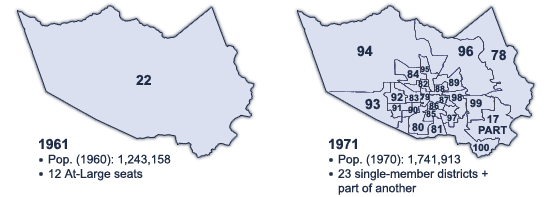|
|
|
State House District Maps, Harris County, Texas |
|

| |
| Until the early 1960s, the Texas Legislature used at-large voting in urban counties like Harris county, home of Houston, to restrict representation for big cities and their resident minorities. By the 1970s, several U.S. Supreme Court decisions and federal legislation like the Voting Rights Act had forced long-overdue implementation of the principle of "one person, one vote" and brought greater representation for minorities. | |
|
Much of the history of redistricting has centered on the issue of race. The drawing of district lines has repeatedly been used to minimize minority representation, though the tools and methods used to accomplish these objectives have changed along with the legal and political contexts. Several tools in drawing districts have been used, but the primary means were minority vote concentration and minority vote dilution. Other tools used were essentially variations on these two core techniques. The goal of minority vote concentration is to put as many minorities as possible into as few districts as possible, so that they control as few seats in the state legislature or U.S. House as possible. Sometimes, though, it is easier to simply scatter minorities across as many districts as possible, so that their influence in any single district is minimized, and their overall influence as a unified voting block is diluted. In practice both techniques are often used in conjunction with each other. Such techniques also have been used by political parties and special interests against other parties and interests, not just against racial and ethnic minorities. Nevertheless, redistricting and racial politics share a long common history. At-large and multi-member districts In practice, such multi-member districts were typically used to dilute the voting power of urban and largely minority areas. Combining these areas with predominantly white, non-urban areas into a single multi-member district had the effect of denying minorities control of the geographic areas where they were the majority. Until the 1970s, Texas counties with more than one seat in the House – the largest urban counties in the state – were represented by multi-member districts. In 1971 the three largest counties (Harris, Dallas and Bexar) were redrawn into multiple single member districts.1 Later, in 1975, the remaining large counties abandoned their multi-member districts in response to court order and the threat of further legal action.2 
Mandated majority-minority districts During the presidential administration of George H. W. Bush (1989-1992), the Department of Justice interpreted Section 5 of the VRA as saying that if a so-called "majority-minority" district (a district in which racial/ethnic minorities are the majority in the district) can be drawn, then it must be drawn. A consequence of this ruling was concentration of Democratic voters (in most areas covered by the VRA most of the affected minorities tended to vote Democratic), thereby increasing the number of Republican controlled districts.3 In some areas the strategy worked, but Texas Democrats controlling the Legislature in 1991 used some creative cartography (strangely shaped districts) to comply with the DOJ interpretation while still preserving Democratic advantages. In the 1993 and 1995, the U.S. Supreme Court reversed the DOJ interpretation of the VRA by ruling that maximizing majority-minority districts is not sufficient reason for race-based redistricting. The incentives created by the redistricting process in the two-party system in Texas and the U.S. will always lead one party to attempt to concentrate or dilute the votes of the other. As long as race and ethnicity are meaningful political categories, minority racial and ethnic groups will be factors in this process. This is particularly evident in Texas, where African Americans, Latinos, and Anglos remain meaningful political categories. |
|
|
Source: FBI Uniform Crime Reports. (full source) |